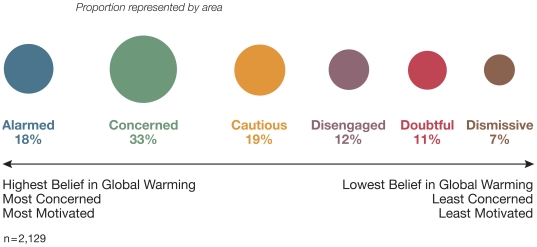Audience Analysis & Segmentation
19 Applying Audience Segmenting to SDGs

An integral part of strategic planning for a public engagement campaign involves selecting the target audiences that are the best fit for the organization’s public engagement goals and resources. Depending on their goals and resources, some organizations might be well served to focus their entire effort on a single target audience. Other organizations might be best served by targeting several audiences. Regardless, campaigns that target specific audiences and tailor their materials accordingly are more likely to achieve their public engagement objectives than campaigns that do not.
For any given organization, the optimal target audiences are those that are likely to maximize the return on investment in campaign planning and execution. The three most relevant considerations in making that determination are the size of the audience segment, the likelihood that members of the segment will respond in an intended manner, and the organization’s ability to reach that segment with its current resources.
Here is an example of developing an Audience Segmentation based around a SDG (Sustainable Development Goal). In this case, the example is SDG #13: Climate Action.
Example: Developing an Audience Segmentation for SDG #13: Climate Action
The principal aim of this research was to identify audience segments within the American adult population that could be considered as potential targets for global warming public engagement campaigns. The nature of the global warming public engagement challenge – e.g., the need to build public understanding and support for appropriate public policies, and to change the behaviour of large numbers of people – necessitated that we adapt and extend previously used segmentation methods.
Specifically, there is a strong precedent in the research literature for segmenting audiences based on what people are doing (behaviours) and why (motivations). That method is well suited to population behaviour change campaigns (e.g., smoking cessation campaigns), but it largely ignores a second potential focus for global warming public engagement campaigns: building public understanding of and support for appropriate public policies.
They conducted a nationally representative survey of adults and used three major categories of variables as inputs into a segmentation analysis: global warming motivations, behaviours, and policy preferences. The global warming motivations category included two distinct sub-categories: beliefs about global warming and the degree of involvement in the issue. They measured a total of 36 variables across these four categories. Find more details on the survey method below:
Survey Method
In September through October of 2008, they conducted a nationally representative survey of American adults using KnowledgePanel, an online panel operated by Knowledge Networks. Recruited nationally using random-digit dialing (RDD) telephone methodology, KnowledgePanel is representative of the U.S. population. The panel tracks closely the December 2007 Current Population Survey (published jointly by the U.S. Census Bureau and the Bureau of Labor Statistics) on age, race, Hispanic ethnicity, geographic region, employment status, and other demographic variables.
The length of our questionnaire – a 50-minute completion time for the average respondent – exceeded what most respondents are willing to answer in a single session. As a result, we divided the content of the instrument into two separate questionnaires. An invitation to participate in the first survey was emailed to 3,997 randomly selected panel members. A total of 2,496 completed the questionnaires, a 62% cooperation rate. Two weeks after administration of the first survey was ended, respondents to the first survey received an invitation to participate in the second survey. Completed questionnaires were received from 2,164 respondents, an 87% cooperation rate, leading to an overall 54% within panel completion rate for the study. The period of administration for each survey – from invitation to termination of data collection – was approximately 10 days, during which one reminder email was sent to non-respondents.
To reduce the effects of any non-response and non-coverage bias in the overall panel membership, a post-stratification adjustment was applied using demographic distributions from the most recent data from the Current Population Survey (CPS). Benchmark distributions for Internet Access among the U.S. population of adults are obtained from KnowledgePanel recruitment data since this measurement is not collected as part of the CPS.
The post-stratification variables were:
- Gender: (Male/Female);
- Age: (18-29, 30-44, 45-59, and 60+);
- Race/Hispanic Ethnicity: (White/Non-Hispanic, Black/Non-Hispanic,
- Other/Non-Hispanic, 2+ Races/Non-Hispanic, Hispanic);
- Education: (Less than High School, High School, Some College, Bachelor and beyond);
- Census Region: (Northeast, Midwest, South, West);
- Metropolitan Area: (Yes/No);
- Internet Access: (Yes/No).
To view and analyze each aspect of the variables researched to great the segmentation. Click here to see the full journal, including the tables: Identifying Like-Minded Audiences for Global Warming Public Engagement Campaigns: An Audience Segmentation Analysis and Tool Development
Additional profiling information about the audience segments – i.e., how the six segments differ with regard to a range of additional relevant beliefs, behaviours (including media use), values, and demographics – is available at link 2 in the continued learning section.
The six identified segments – each of which was given a concise name to summarize its essential qualities – differ dramatically with regard to what they believe about global warming, how engaged they are with the issue, what they are doing about it, and what they would like to see American government officials, businesses, and citizens do about it. The six segments also differ with regard to size: the largest represents 33% of the U.S. adult population, and the smallest only 7% (Figure 1). These six audience segments represent a spectrum of concern and action about global warming, ranging from the Alarmed (18% of the population), to the Concerned (33%), Cautious (19%), Disengaged (12%), Doubtful (11%) and Dismissive (7%).
The proportion of the U.S. Adult Population in the Six Segments

Alarmed 18%
In brief, the Alarmed are the segment most engaged in the issue of global warming. They are very convinced it is happening, human-caused, and a serious and urgent threat. The Alarmed are already making changes in their own lives and support an aggressive national response.
Members of the Alarmed segment are a highly engaged and active audience, at least in their capacity as consumers (with the exception of their travel behaviour, which is more or less similar to that of other segments). They have a strong demonstrated tendency to use their consumer purchasing power to reward businesses they believe are contributing to solutions and punish businesses they believe are not. They are markedly less active in their role as citizens, however; only about one in four had contacted an elected official in the past year to urge them to take action to reduce global warming. Organizations seeking to promote policy advocacy – and possibly those seeking to modify people’s travel behaviour — should consider targeting this audience.
Concerned 33%
The Concerned are also convinced that global warming is a serious problem, but while they support a vigorous national response, they are distinctly less involved in the issue and less likely than the Alarmed to be taking personal action.
Members of the Concerned segment are moderately engaged in the issue, but they are less active than are the Alarmed. As a result of their high prevalence in the population (1 out of every 3 adults), and their high stated intention to use their consumer purchasing power more frequently in the future to reward businesses they believe are contributing to solutions, organizations seeking to promote change through markets – rather than, or in addition to, change through public policy – should consider targeting this audience.
Cautious 19%
The Cautious also believe that global warming is a problem, although they are less certain that it is happening than the Alarmed or the Concerned. They don’t view it as a personal threat and don’t feel a sense of urgency to deal with it through personal or societal actions.
Members of the Cautious segment are only modestly engaged in the issue, and they don’t appear ready to take action either as consumers or citizens. Organizations that are interested in expanding the number of Americans who are actively considering the issue of climate change (rather than attempting to change people’s behaviour, or develop support for policy responses) should consider targeting members of this audience. Narrative-based communication, and reframing the issue in terms of human health may be productive approaches.
Disengaged 12%
The Disengaged haven’t thought much about the issue. They are the segment most likely to say that they could easily change their minds about global warming, and they are the most likely to select the “don’t know” option in response to every survey question about global warming where “don’t know” was presented as an option.
Members of the Disengaged segment currently have no involvement in the issue. The Disengaged stand apart from other segments in that they are less educated and have lower household incomes, both of which place them at a higher than average risk of being harmed by global warming. This is a difficult segment to reach using news media and other traditional science communication channels, both due to their current lack of interest and their financial challenges. Organizations seeking to engage members of the Disengaged must think creatively about how to make the issue more relevant for them. As with the Cautious segment, narrative-based communication, and reframing the issue in terms of human health may be productive approaches. Activating new voices to explain the relevance of climate change – such as health professionals, members of the faith community, and organizations serving low-income families – may be helpful as well.
Doubtful 11%
The Doubtful are evenly split among those who think global warming is happening, those who think it isn’t, and those who don’t know. Many within this group believe that if global warming is happening, it is caused by natural changes in the environment, that it won’t harm people for many decades into the future, if at all, and that America is already doing enough to respond to the threat.
Members of the Doubtful segment are important because – although they currently doubt that global warming is real or harmful, and are disinclined to support actions to address it – they remain open to learning more about this issue. Because the Doubtful tend to be politically conservative, organizations that have the ability to work effectively across the political spectrum should consider developing activities to further engage the Doubtful.
Dismissive 7%
Finally, the Dismissive, like the Alarmed, are actively engaged in the issue, but on the opposite end of the spectrum. The large majority of the people in this segment believe that global warming is not happening, is not a threat to either people or non-human nature, and is not a problem that warrants a personal or societal response.
As a result of their strongly held belief that global warming is not happening or is not human-caused, members of the Dismissive segment are highly involved in the issue as adamant opponents to taking any form of action against global warming. As members of the Alarmed segment, however, they are supportive of taking both personal and societal actions to reduce energy use. Thus, while they are likely not a productive audience for global warming public engagement campaigns per se, they may be an attractive audience for energy-efficiency campaigns because they are receptive to such appeals.
Continued Learning
Please refer to the links below if you would like to continue your learning on these topics.
- The full list of all 17 SDGs, and information about them.
- Additional profiling information about the audience segments.
Attribution
This page contains materials taken from:
Maibach, E., Leiserowitz, A., Roser-Renouf, C., & Mertz, C. (2011, March 10). Identifying Like-Minded Audiences for Global Warming Public Engagement Campaigns: An Audience Segmentation Analysis and Tool Development. Retrieved July 23, 2020, from https://journals.plos.org/plosone/article?id=10.1371%2Fjournal.pone.0017571

